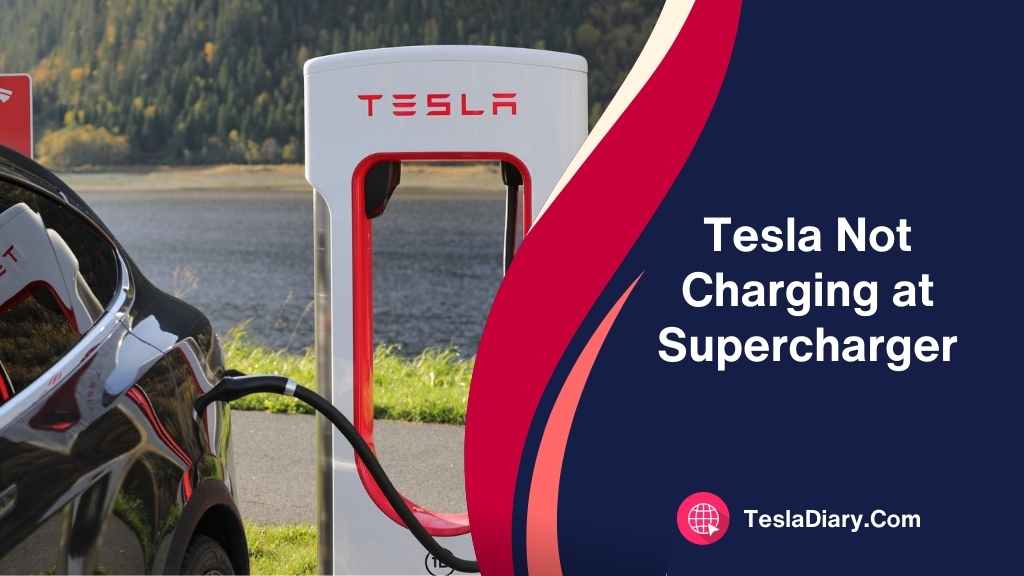Tesla electric vehicles (EVs) are renowned for their innovative technology and the convenience of using the extensive Supercharger network for fast charging.
However, encountering an issue where your Tesla refuses to charge at a Supercharger can be perplexing and inconvenient.
In this comprehensive article, we’ll delve into the potential reasons behind this problem and provide detailed troubleshooting steps to help you get back on the road swiftly.

1. Check the Supercharger Status
The starting point when your Tesla is not charging at a Supercharger is to confirm the operational status of the Supercharger station itself.
You can do this conveniently through the Tesla mobile app or your car’s in-car navigation system.
If the station is marked as “unavailable” or is experiencing issues, it’s entirely possible that the problem lies with the Supercharger, not your Tesla.
2. Properly Insert the Charging Cable
Before diving into complex troubleshooting, ensure that you have correctly and securely inserted the charging cable into both your Tesla’s charging port and the Supercharger stall.
Sometimes, a loose or improperly inserted cable connection can be the root cause of the issue, preventing the charging process from initiating.
3. Unlock the Charging Port
Your Tesla needs to be in the right state for charging to commence. It’s essential to verify that your vehicle is unlocked, and it should also be in “Park” mode for the charging port to automatically unlock.
If, for any reason, the port doesn’t unlock, double-check that the car is correctly configured for charging.
4. Check for Error Messages
Tesla vehicles are equipped with an informative touchscreen interface. This interface often displays error messages or notifications when issues occur during the charging process.
Take a moment to scrutinize the screen for any error messages, as they can offer valuable insights into the nature of the problem.
If you find any, check the solution in the Tesla owner’s manual for a faster solution.
However, if you don’t see any error messages, I still recommend a quick restart of your vehicle. Go to Controls > Safety > Power Off. Wait for a couple of minutes and start the vehicle again normally to see if the problem persists or not.
While turned off, do not interact with any of the Tesla features, i.e. refrain from opening the door, touching the braking pedal or using the touchscreen.
5. Inspect the Charging Cable
A thorough inspection of the charging cable is crucial. Look for any visible damage, kinks, or wear along the cable’s length.
If you spot any issues with the cable itself, such as exposed wires or frayed insulation, it may not establish a reliable connection with the Supercharger. In such cases, the best course of action is to use a supercharger stall with good cable.
There have been a lot of cable-cutting issues at Superchargers lately where vandals cut the cables. I don’t know the motive but it has become a pain in the A-word.
6. Restart the Charging Session
If you encounter issues during the charging process, it’s worth trying a simple yet effective step: stopping and restarting the charging session.
This can resolve minor glitches that may be preventing the charging process from proceeding smoothly.
You can simply stop charging. Wait a couple of minutes before starting again to charge the vehicle.
7. Check for Overheating
Tesla vehicles employ sophisticated battery management systems to protect the battery from extreme conditions.
If your Tesla’s battery is excessively hot, it may limit charging to prevent overheating and potential damage. This is especially true with the superchargers as the charging speed is pretty high. Tesla batteries are high quality, yet the rapid charge might stress the battery out sometimes.
To address this, park your Tesla in a shaded area or turn off the climate control to allow the battery to cool down before attempting to charge again.
8. Verify Your Tesla Account and Payment
It’s crucial to ensure that your Tesla account is in good standing and that your payment method is up to date.
Any issues related to your account or payment can significantly impact your ability to utilize Superchargers.
Verify that your account information is accurate to avoid complications tied to payment processing.
Although I am listing at number 8, this is one of the most common causes of Tesla not charging at superchargers. People do not pay the due payments or their cards get declined which results in the supercharger not allowing the current to pass through to the vehicle.
9. Software Update
Tesla frequently releases software updates that can affect various aspects of your vehicle, including the charging process.
To ensure the best charging experience, make sure your Tesla’s software is up to date.
An outdated software version may potentially cause charging issues that can be resolved with a simple update.
10. Contact Tesla Support
If you’ve diligently followed the above steps and your Tesla still refuses to charge at a Supercharger, it’s advisable to contact Tesla’s dedicated customer support or visit a Tesla Service Center for expert assistance.
Tesla’s support team possesses the capability to remotely diagnose the issue and provide guidance. They can also schedule a service appointment if necessary to resolve more complex problems.
Wrapping Up
When your Tesla encounters issues while charging at a Supercharger, it’s essential to remain composed and systematically work through the troubleshooting process. Unless you are banned from using supercharger, there is nothing to worry about.
While most problems can be resolved with straightforward steps, don’t hesitate to reach out to Tesla’s official support channels if the issue persists.
Tesla’s charging infrastructure and technology continue to evolve, and staying informed about software updates and maintenance recommendations is key to ensuring a seamless charging experience for your EV.

